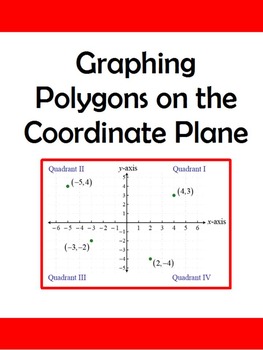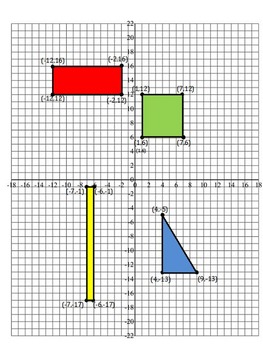Graphing Polygons on the Coordinate Plane to Find Area/Perimeter
True Education
236 Followers
Resource Type
Standards
CCSS6.G.A.1
CCSS6.G.A.3
CCSS6.NS.C.5
CCSS6.NS.C.6a
CCSS6.NS.C.6c
Formats Included
- Word Document File
Pages
10 pages
True Education
236 Followers
What educators are saying
This was a great resource to use for practicing plotting points and finding area of polygons in the coordinate plane.
Used this to begin teaching my student this standard. We went through some of the lesson and will be able to return to review.
Description
This activity asks the students to plot various ordered pairs on a coordinate plane and connect the points to make a polygon. Then they are expected to calculate the area and/or perimeter of each shape. The first worksheet has a square, two rectangles and a triangle. The triangle is starred to show higher level thinking. Each polygon is to be colored a different color. The second worksheet asks the students to plot the points of five polygons: a triangle, two rectangles and two composite figures. There is a "hint" to break down the composite figures into two smaller figures. Also, two of the polygons cross the y axis so this is a good time to introduce absolute value.
Total Pages
10 pages
Answer Key
Included
Teaching Duration
45 minutes
Report this resource to TPT
Reported resources will be reviewed by our team. Report this resource to let us know if this resource violates TPT’s content guidelines.
Standards
to see state-specific standards (only available in the US).
CCSS6.G.A.1
Find the area of right triangles, other triangles, special quadrilaterals, and polygons by composing into rectangles or decomposing into triangles and other shapes; apply these techniques in the context of solving real-world and mathematical problems.
CCSS6.G.A.3
Draw polygons in the coordinate plane given coordinates for the vertices; use coordinates to find the length of a side joining points with the same first coordinate or the same second coordinate. Apply these techniques in the context of solving real-world and mathematical problems.
CCSS6.NS.C.5
Understand that positive and negative numbers are used together to describe quantities having opposite directions or values (e.g., temperature above/below zero, elevation above/below sea level, credits/debits, positive/negative electric charge); use positive and negative numbers to represent quantities in real-world contexts, explaining the meaning of 0 in each situation.
CCSS6.NS.C.6a
Recognize opposite signs of numbers as indicating locations on opposite sides of 0 on the number line; recognize that the opposite of the opposite of a number is the number itself, e.g., -(-3) = 3, and that 0 is its own opposite.
CCSS6.NS.C.6c
Find and position integers and other rational numbers on a horizontal or vertical number line diagram; find and position pairs of integers and other rational numbers on a coordinate plane.





